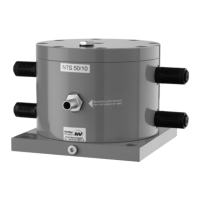Setting the frequency
The frequency of the NTS is set with the pressure regulator of the maintenance unit.
The frequency is reduced by lowering the air pressure before the NTS. The centrifugal force
is hereby also reduced. At the same time the amplitude remains almost constant.
Adjustment of amplitude
If required, install a throttle valve in the exhaust air line in order to adjust the amplitude of the
NTS by throttling the exhaust air. By throttling the exhaust air, the centrifugal force is reduced.
The frequency hereby remains almost constant.
Important: Reduced cross-sections already throttle (observe the nominal diameter).
Reduce the amplitude only up to approx. 50 %. This can cause start-up problems if below.
Setting mist lubricator
Set the mist lubricator to the recommended number of drops while the NTS is running.
Notice: The NTS is ready for operation only after adjustment and correct functioning of the
mist lubricator.
Stop-intervals
During operation at very short stop intervals (< 1 s), it is possible that the NTS will not start
immediately. The reason for this is that the piston has not yet been pushed into the end posi-
tion by the spring (NTS version 1) or by gravity (NTS version 2).
8 Maintenance and servicing
Observe the safety instructions in chap. Safety, from page 3 on.
Maintenance intervals
The maintenance intervals depend essentially on the service life and how clean the drive me-
dium is. Unfiltered compressed air leads to high wear, silencer clogging or complete failure of
the NTS.
Feature NTS 80 - 350
A base-plate is screwed into the housing of NTS 80 to 350. The following bores are in the
base-plate:
• a mounting bore with metric thread,
• two smaller bores to detach and attach the base-plate.
After one hour of
operation after initial
commissioning
Check fastening and housing screws.*
Check hose screw connections and hose fittings, retighten if necessary.
Check fastening and housing screws.*
Check hose screw connections and hose fittings, retighten if necessary.
Check hose supply connections for permeability and kinks. If necessary, clean and re-
move kinks.
Check the function of the silencer. Clean silencer.

